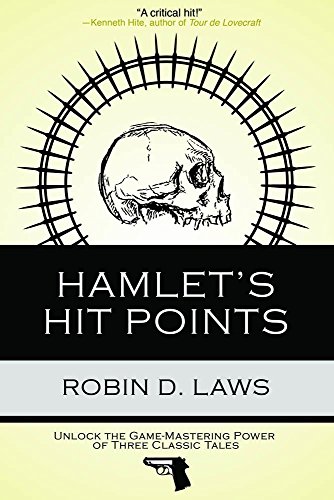
Hamlet’s Hit Points has been recommended to me a number of times by people with experience in RPGs, narrative, or systems design. Since I’ve recently been thinking and writing more about the stats-and-point-assignment aspects of narrative design, I came back to the recommendation this month. (It’s available as a physical book from various places including Amazon, but for various reasons I’m linking to Amazon less. You can get the book as downloadable content for $8 from DriveThruRPG, so that’s what I’ve linked.)
Hamlet’s Hit Points starts by acknowledging the influence of Hollywood writing guides of the kind I’ve sometimes covered here, and then offers its own kind of structural analysis of story beats, intended to cover both conventional narratives and RPGs. (The book is focused on tabletop RPGs with a human game master.)
Laws acknowledges beat types such as
Procedural: the protagonist is advancing towards their goal (or trying to) in a practical way, like gaining a map to the next stage of their quest, or getting the cooperation of an NPC.
Dramatic: the protagonist is dealing with an emotional conflict, perhaps trying to reach an emotional concession from another character.
Commentary: a pause which functions like a Greek chorus to bring out the story’s major themes.
Several specialist mood beats: anticipation, which looks forward to a hero’s future victory; gratification, which revels in some pleasant emotional stimulus; bringdown, the mood-lowering moment, which perhaps accentuates what the protagonist is already feeling.
And several expository beats as well: pipe, which sets up information that will be used later; question; and reveal.
Much of the rest of the book is dedicated to analyzing classic plots in terms of these beat types, and discussing how they work. There’s a long section on Hamlet, another on Dr No, and so on. These are illustrated with commentary explaining why each beat counts as it does, and sometimes offering reflections about how such moments would need to be translated or altered for a (tabletop) roleplaying context.
At their best, these observations shed light on level pacing. For instance, speaking of a moment in Dr No when Bond realizes he has an opponent he can easily overcome:
RPG encounters tend by default to challenge the PCs. Some wear them down, depriving them of resources and making later fights tougher than they otherwise would be. Then you get the extremely tough boss fights, requiring luck, skill and heavy preparation to get to.
Moments like this remind us of the value of encounters that are meant to be easily mastered. To achieve the effect, though, you have to let the players know as a given that they can overcome the opposition. By saying, “You know you can take this guy,” as Bond’s GM is clearly whispering in his ear, you create anticipation, and the special kind of up note like the one presented here.
And many of the other brief suggestions could easily be adapted to a computer context. As Laws points out, in the right circumstances, even just telling people to check a particular skill (“Make a perception check”) can have them suddenly apprehensive or anticipatory.
Or again, this passage could be taken as advice about escort quests and other in-game travel:
Make your journey sequences earn their keep, becoming more than just confrontations with meaningless plot impediments. Construct obstacles so that they activate a PC’s internal conflicts, or provide the opportunity to alter relationships within the group. If supporting characters are along for the ride, relationships with them might likewise be sharpened by procedural beats encountered during a journey.
Overall, I did find myself skimming a fair amount, because the book’s dedication to thoroughness meant breaking down every moment of these plots, sometimes when there wasn’t all that much to say about a particular beat.
The author seems to be aware of that, though, and it’s very much structured to help out a time-pressured reader: there’s guidance in the first chapters about how you might want to approach the book if you need to skip parts, and many key points are called out as sidebars in the body text.
Related:
- Story book review, where I talk about my own schema for breaking down moves into advancing, exploring, and idling — a somewhat simpler division and one that doesn’t distinguish dramatic from procedural advancements, but useful in my experience for game constructs
- Plot, Scene by Scene. An older article of mine about dividing a story up into types of interaction in order to implement it, usually as parser IF. Similar approaches could apply in other types of gameplay, though text adventures offer the creator a lot of scope to change verbs from one part of the story to the next without making the story feel discontinuous.
- Level Up! A book review of another book that speaks to game design considerations (though with only a light focus on narrative specifically).
- Beyond Hitpoints is an article by Geek Dad (Greg Howley), exploring the point mechanics in Pillars of Eternity.
One thought on “Hamlet’s Hit Points (Robin D. Laws)”